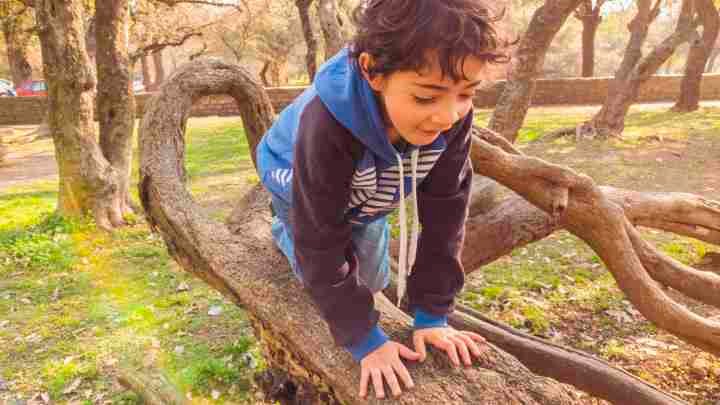In today’s fast-paced and competitive world, it’s natural for parents to want to protect their children and ensure their success. However, this can sometimes lead to a phenomenon known as helicopter parenting, where parents become overly involved and controlling in their children’s lives. While the intentions behind this parenting style may be well-meaning, finding a balance between offering guidance and support, and allowing children the freedom to grow and explore independently is crucial for their long-term development and well-being. In this blog post, we will discuss the risks associated with helicopter parenting, and provide practical tips and strategies to help you foster independence, creativity, and resilience in your children without hovering over their every move.
Understanding the Risks of Helicopter Parenting
Helicopter parenting can inadvertently undermine a child’s self-esteem and confidence. When parents constantly intervene and make decisions for their children, it sends a message that the child is not capable of handling situations on their own. This can lead to a lack of self-trust, self-doubt, and reliance on external validation.
Overprotective parenting may also hinder the development of essential problem-solving and decision-making skills. Children learn best through experience, trial, and error. By not giving them the opportunity to face challenges, make mistakes, and learn from their experiences, parents may unintentionally limit their children’s ability to think critically and make sound decisions in the future.
Excessive parental involvement can also contribute to increased anxiety and stress in children. When parents constantly hover, children may feel pressured to meet high expectations and perform perfectly in every situation. This can lead to a fear of failure and an unhealthy preoccupation with perfectionism. Additionally, children who have not been given the opportunity to develop coping mechanisms and self-regulation skills may struggle to manage stress and anxiety independently as they grow older.

Promoting Independent Play and Exploration
One of the key aspects of fostering independence in children is creating a safe and secure environment where they can explore and learn without constant supervision. This may involve childproofing your home, setting up designated play areas, and providing age-appropriate toys and activities that encourage curiosity and creativity. By giving your child the freedom to explore within safe boundaries, you promote self-discovery and autonomy.
It’s essential to offer a variety of age-appropriate activities and games that stimulate your child’s cognitive, physical, and emotional development. Encourage activities that promote problem-solving, creativity, and collaboration, such as puzzles, building blocks, and imaginative play. Outdoor play is also crucial, as it allows children to develop motor skills, learn about their environment, and interact with their peers. Offering a balance of structured and unstructured activities helps children learn to manage their time and make choices independently.
Mistakes are a natural part of learning and growth, and it’s crucial that children be allowed to experience setbacks and learn from them. Rather than swooping in to fix every problem, give your child the space to work through challenges and come up with their solutions. Offer guidance and support when needed, but refrain from taking over completely. This approach will help your child develop resilience, adaptability, and a sense of accomplishment as they overcome obstacles and grow from their experiences.
Fostering Emotional Independence
Helping children develop emotional independence involves teaching them to identify and express their feelings effectively. Encourage open conversations about emotions and validate your child’s feelings, even if they differ from your own. By doing this, you create a safe space for them to explore their emotions and learn how to communicate them constructively.
Another crucial aspect of emotional independence is learning self-soothing and self-regulation techniques. Teach your child coping strategies such as deep breathing exercises, mindfulness practices, or engaging in a calming activity like drawing or listening to music. By providing them with tools to manage their emotions, you empower them to handle stress and anxiety independently as they grow older.
To foster emotional independence, it’s essential to gradually increase your child’s responsibilities and give them opportunities to make decisions. Start with small tasks such as choosing their clothes, organizing their toys, or helping with simple household chores. As your child becomes more comfortable and confident, you can introduce more significant decisions and responsibilities. This gradual approach allows your child to develop a sense of autonomy and self-efficacy, preparing them for more complex decision-making situations in the future.
Setting Healthy Boundaries
Setting healthy boundaries involves establishing clear and consistent expectations for your child’s behavior and actions. Communicate these expectations openly and ensure that your child understands the reasons behind them. By providing structure and guidance, you help your child develop self-discipline and a sense of responsibility, while also giving them the freedom to explore within the established boundaries.
Allowing your child to experience the natural consequences of their actions is a powerful way to teach them responsibility and accountability. Instead of always stepping in to shield them from the outcomes of their decisions, let them face the results and learn from their mistakes. This approach helps your child develop a better understanding of cause and effect, and encourages them to think through their decisions more carefully in the future.
It’s essential to strike a balance between offering guidance and support, and allowing your child to take ownership of their tasks and responsibilities. Encourage your child to ask for help when needed, but avoid the temptation to take over and complete the task for them. By giving them the opportunity to work through challenges and develop their skills, you foster self-reliance and resilience, while still providing a supportive safety net.
Building a Supportive Parent-Child Relationship
Open communication is vital for building a strong and supportive parent-child relationship. Encourage your child to express their thoughts, feelings, and concerns, and actively listen without judgment or criticism. This creates an environment of trust and understanding, where your child feels comfortable coming to you for guidance and support while also respecting their autonomy.
Recognize and celebrate your child’s achievements, milestones, and progress, no matter how big or small. This not only boosts their self-esteem and confidence but also reinforces the importance of effort, perseverance, and self-improvement. Remember to also acknowledge their attempts and progress, even if they don’t always succeed. This helps to create a growth mindset and a positive attitude towards learning and personal development.
A supportive parent-child relationship involves finding a balance between spending quality time together and allowing your child the space to engage in independent activities. Plan family activities and one-on-one time to bond and create shared memories, but also ensure that your child has ample opportunities to explore, play, and learn on their own. This balance helps to nurture a strong, trusting relationship, while also fostering your child’s independence and self-reliance.
Tips for Parents to Avoid Over-Hovering
It’s essential to regularly reflect on your parenting style and consider your motivations behind your actions. Are you stepping in to help your child out of genuine concern, or are you acting out of fear or a desire to control? By becoming more self-aware and mindful of your own behaviors, you can identify areas where you may need to take a step back and allow your child more autonomy.
Connecting with other parents, joining parenting groups, or seeking guidance from professionals can provide valuable insights and perspectives on fostering independence in children. Sharing experiences and discussing different approaches can help you identify strategies that work best for you and your child, as well as offer reassurance and support as you navigate the challenges of parenthood.
Cultivating self-awareness and mindfulness can help you recognize when you may be overstepping boundaries or hovering too closely. Pay attention to your child’s cues and reactions, and be open to adjusting your approach as needed. Remember that fostering independence is an ongoing process that requires patience, flexibility, and a willingness to learn from both successes and setbacks.
Recognizing the Benefits of Balanced Parenting
By striking a balance between guidance and autonomy, you encourage the development of resilience and self-sufficiency in your children. This equips them with the ability to bounce back from challenges, adapt to new situations, and rely on their own skills and resources when faced with difficulties.
Balanced parenting fosters the development of problem-solving and critical thinking skills in children. By allowing them to tackle challenges and make decisions independently, you empower them to think creatively, analyze situations, and come up with innovative solutions, preparing them for success in various aspects of life.
Children who are given the freedom to explore, play, and learn without constant supervision tend to develop a strong sense of curiosity and creativity. This intrinsic motivation to discover and learn drives their intellectual, emotional, and social growth, enabling them to reach their full potential.
Finally, balanced parenting helps to strengthen the parent-child bond by fostering a relationship built on trust and mutual respect. When children feel supported and understood, yet are given the autonomy to grow and learn independently, they are more likely to develop a strong sense of trust in themselves and their parents, leading to a healthier, more fulfilling relationship for both parties.
Conclusion
In conclusion, finding a balance between providing guidance and support, and allowing children the freedom to explore and develop independently is crucial for their long-term well-being and success. By avoiding the pitfalls of helicopter parenting and adopting a more balanced approach, you help your child cultivate essential skills, such as resilience, problem-solving, and self-sufficiency, while also nurturing a strong and supportive parent-child relationship.
As parents, it’s essential to continually reflect on and adjust our parenting styles to meet the evolving needs of our children. Be open to learning from your experiences, seeking support from others, and adapting your approach as your child grows and develops. Remember that fostering independence is an ongoing process that requires patience, understanding, and a willingness to grow alongside your child.
The long-term benefits of balanced parenting extend to both children and parents. Children who are given the opportunity to develop independence and self-reliance are more likely to thrive academically, socially, and emotionally, while parents who embrace a balanced approach enjoy a stronger, more trusting, and fulfilling relationship with their children. By striking the right balance, you set the stage for a lifetime of growth, learning, and success for your child and a rewarding parenting journey for yourself.




Good post. I learn something totally new and challenging on blogs I stumbleupon on a daily basis. Its always useful to read content from other authors and practice something from their websites.